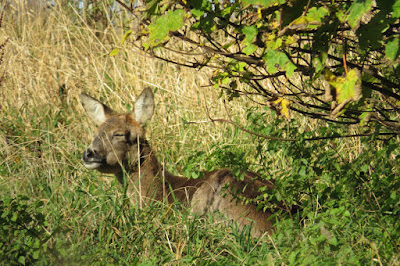I started off by counting the thrushes in the paddocks again, getting totals of 206 Redwings, 22 Fieldfares, five Meadow Pipits, and 21 Starlings. Pretty similar to last time. Clearly the lack of frost is giving these birds an earthworm bonanza.
Then I decided to walk along the road. This produced a singing Mistle Thrush, and a photogenic Treecreeper.
 |
| Treecreeper |
Down at pool (once again reduced to a puddle) I heard the Water Rail calling from almost exactly where I had flushed it a fortnight ago. A single male Stonechat appeared to be unringed, so was different to the two the ringers caught yesterday.
Approaching the flash field I noticed a black and white bird, which proved to be a Shelduck. Curiously, the first Shelduck of last spring arrived at the end of December too. Scanning to the right of the Shelduck I spotted an interesting looking duck. I thought I knew what it might be, but convinced myself to wait until I got closer. Arriving at the viewing point I was delighted to find it was indeed a female Pintail. The first here since Feb 2012.
 |
| Pintail |
 |
| Shelduck |
Next year I plan to relax a bit, do a few different sites, but will no doubt still be visiting Morton Bagot at least once a week.
Happy New Year.















































